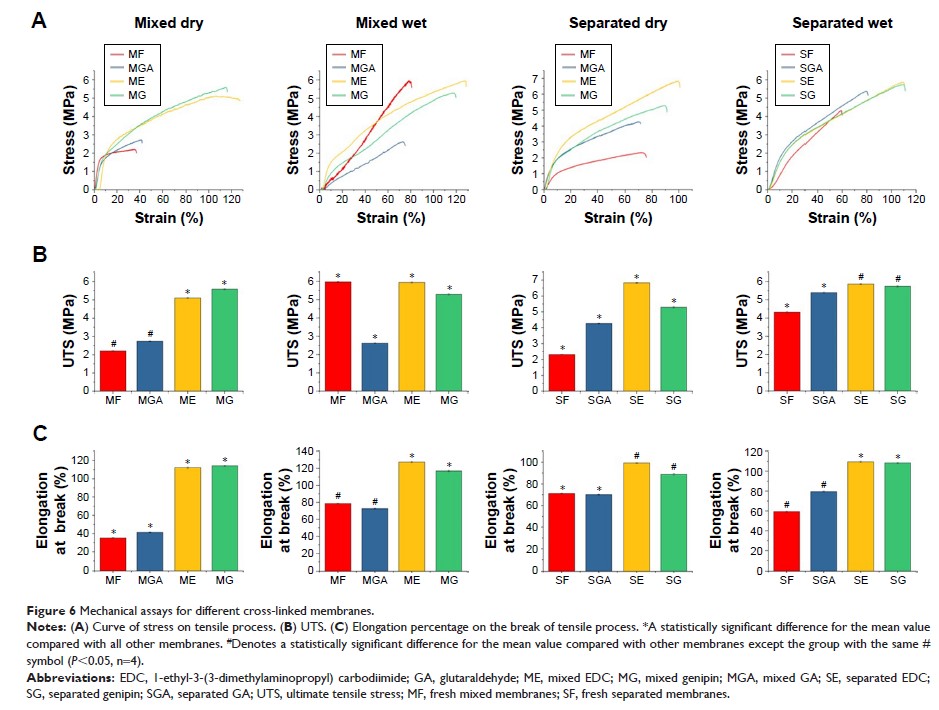108384
论文已发表
注册即可获取德孚的最新动态
IF 收录期刊
- 3.4 Breast Cancer (Dove Med Press)
- 3.2 Clin Epidemiol
- 2.6 Cancer Manag Res
- 2.9 Infect Drug Resist
- 3.7 Clin Interv Aging
- 5.1 Drug Des Dev Ther
- 3.1 Int J Chronic Obstr
- 6.6 Int J Nanomed
- 2.6 Int J Women's Health
- 2.9 Neuropsych Dis Treat
- 2.8 OncoTargets Ther
- 2.0 Patient Prefer Adher
- 2.2 Ther Clin Risk Manag
- 2.5 J Pain Res
- 3.0 Diabet Metab Synd Ob
- 3.2 Psychol Res Behav Ma
- 3.4 Nat Sci Sleep
- 1.8 Pharmgenomics Pers Med
- 2.0 Risk Manag Healthc Policy
- 4.1 J Inflamm Res
- 2.0 Int J Gen Med
- 3.4 J Hepatocell Carcinoma
- 3.0 J Asthma Allergy
- 2.2 Clin Cosmet Investig Dermatol
- 2.4 J Multidiscip Healthc

电纺聚己内酯/胶原纳米纤维与 1-乙基-3-(3-二甲基氨基丙基)碳二亚胺/N -羟基琥珀酰亚胺和京尼平交联促进内皮细胞再生,可能是血管支架有前途的候选药物者
Authors Chen D, Zhu T, Fu W, Zhang H
Received 30 October 2018
Accepted for publication 18 January 2019
Published 26 March 2019 Volume 2019:14 Pages 2127—2144
DOI https://doi.org/10.2147/IJN.S192699
Checked for plagiarism Yes
Review by Single-blind
Peer reviewers approved by Dr Govarthanan Muthusamy
Peer reviewer comments 2
Editor who approved publication: Dr Mian Wang
Purpose: A
promising vascular scaffold must possess satisfying mechanical properties,
great hemocompatibility, and favorable tissue regeneration. Combining natural
with synthetic materials is a popular method of creating/enhancing such
scaffolds. However, the effect of additional modification on the materials
requires further exploration.
Materials and methods: We
selected polycaprolactone (PCL), which has excellent mechanical properties and
biocompatibility and can be combined with collagen. Electrospun fibers created
using a PCL/collagen solution were used to fashion mixed nanofibers, while
separate syringes of PCL and collagen were used to create separated nanofibers,
resulting in different pore sizes. Mixed and separated nanofibers were
cross-linked with glutaraldehyde (GA), 1-ethyl-3-(3-dimethylaminopropyl)
carbodiimide (EDC), and genipin; hence, we named them as mixed GA, mixed EDC
(ME), mixed genipin (MG), separated GA, separated EDC (SE), and separated
genipin (SG).
Results: Fourier
transform infrared (FTIR) spectroscopy and X-ray diffraction showed that
cross-linking did not affect the main functional groups of fibers in all
groups. ME, MG, SE, and SG met the requisite mechanical properties, and they
also resisted collagenase degradation. In hemocompatibility assays, only ME and
MG demonstrated ideal safety. Furthermore, ME and MG presented the greatest
cytocompatibility. For vascular scaffolds, rapid endothelialization helps to
prevent thrombosis. According to human umbilical vein endothelial cell
migration on different nanofibers, ME and MG are also successful in promoting
cell migration.
Conclusion: ME and MG
may be promising candidates for vascular tissue engineering. The study suggests
that collagen cross-linked by EDC/N -hydroxysuccinimide or genipin facilitates
endothelial cell regeneration, which could be of great benefit in tissue
engineering of vascular scaffolds.
Keywords: tissue
engineering, glutaraldehyde, mechanical test, hemocompatibility, subcutaneous
implantation, migration assay
